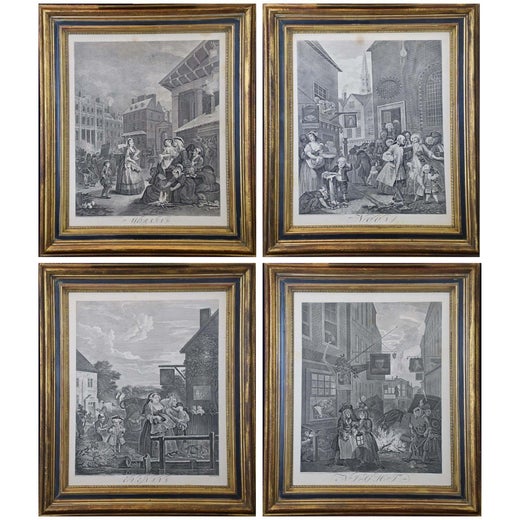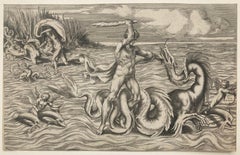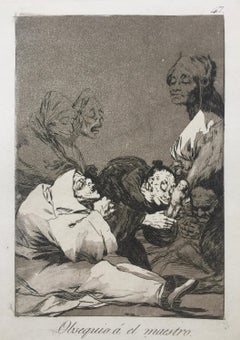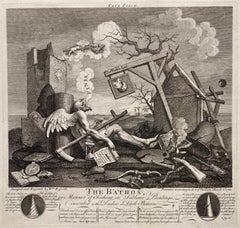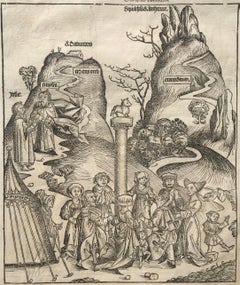Want more images or videos?
Request additional images or videos from the seller
1 of 9
William HogarthMr. Garrick in the Character of Richard the 3rd - FINE IMPRESSION1746
1746
Price:$600
$750List Price
About the Item
- Creator:William Hogarth (1697 - 1764, British)
- Creation Year:1746
- Dimensions:Height: 16.5 in (41.91 cm)Width: 20.56 in (52.23 cm)
- Medium:
- Movement & Style:
- Period:1740-1749
- Condition:
- Gallery Location:Santa Monica, CA
- Reference Number:1stDibs: LU41138514082
William Hogarth
William Hogarth (1697-1764) was an English painter, printmaker, pictorial satirist, social critic, and editorial cartoonist. Hogarth's work was extremely diverse, ranging from serious realistic paintings and portraits to satire and moralistic pieces filled with symbolism. He often communicated his moral message in a series of paintings and engravings, such as: A Rake's Progress, Marriage A-la-Mode and A Harlot's Progress. He was by far the most significant English artist of his generation and inspired a movement of English caricaturists and satirists, including James Gillray (1756-1815), Thomas Rowlandson (1757-1827), Isaac Cruickshank (1764-1811) and George Cruickshank (1792-1878). His work has been studied intensely for the greater than two and a half centuries since his death with several academic scholars focusing their careers on the analysis of every element of each of his creations.
About the Seller
5.0
Recognized Seller
These prestigious sellers are industry leaders and represent the highest echelon for item quality and design.
Platinum Seller
Premium sellers with a 4.7+ rating and 24-hour response times
Established in 1977
1stDibs seller since 2016
296 sales on 1stDibs
Typical response time: 1 hour
Associations
International Fine Print Dealers Association
Authenticity Guarantee
In the unlikely event there’s an issue with an item’s authenticity, contact us within 1 year for a full refund. DetailsMoney-Back Guarantee
If your item is not as described, is damaged in transit, or does not arrive, contact us within 7 days for a full refund. Details24-Hour Cancellation
You have a 24-hour grace period in which to reconsider your purchase, with no questions asked.Vetted Professional Sellers
Our world-class sellers must adhere to strict standards for service and quality, maintaining the integrity of our listings.Price-Match Guarantee
If you find that a seller listed the same item for a lower price elsewhere, we’ll match it.Trusted Global Delivery
Our best-in-class carrier network provides specialized shipping options worldwide, including custom delivery.You May Also Like
The New Testament /// Old Masters Biblical Religious Engraving Dutch Angel Art
By Michael Burghers
Located in Saint Augustine, FL
Artist: Michael Burghers (Dutch, c.1647/1648-1727)
Title: "The New Testament"
Portfolio: Holy Bible
*Signed by Burghers in the plate (printed signature) lower left
Year: 1680
Medium...
Category
1680s Old Masters Figurative Prints
Materials
Watercolor, Laid Paper, Engraving, Etching, Intaglio
Michael BurghersThe New Testament /// Old Masters Biblical Religious Engraving Dutch Angel Art, 1680
$1,200
H 17.25 in W 10.5 in
A View of the House of Commons /// George II English Parliament London England
Located in Saint Augustine, FL
Artist: Benjamin Cole (English, c. 1697-1783)
Title: "A View of the House of Commons"
Portfolio: The History and Survey of London from its Foundation to the Present Time
Year: 1756 (...
Category
1750s Old Masters Figurative Prints
Materials
Laid Paper, Engraving, Etching
Untitled /// French Ornaments Designs Architecture Jean Bérain Old Master Print
By Jean Bérain
Located in Saint Augustine, FL
Artist: Jean Berain (the Elder) (French, 1640-1711)
Title: "Untitled" (Plate 35)
Portfolio: Ornemens Inventez par J. Berain (Ornament Designs Invented by J. Berain)
Circa: 1711 (Firs...
Category
1710s Old Masters Figurative Prints
Materials
Laid Paper, Engraving, Intaglio, Etching
Meridies; Der Mittag (Noon; The Midday) /// Johann Daniel Preissler Old Master
Located in Saint Augustine, FL
Artist: (after) Johann Daniel Preissler (German, 1666-1737)
Title: "Meridies; Der Mittag (Noon; The Midday)"
Portfolio: Die Vier Tageszeiten (The Four Times of Day)
Year: 1723
Medium: Original Etching and Engraving on laid paper
Limited edition: Unknown
Printer: likely Johann Balthasar Probst, Augsburg, Germany
Publisher: Jeremias Wolff (Erben), Augsburg, Germany
Reference: Le Blanc No. 255, 38; Nagler No. 23
Sheet size: 22.5" x 16.32"
Image size: 18.13" x 14.32"
Condition: Soft handling creases and folds to sheet. A few light areas of staining and scattered small areas of discoloration in margins. Two small tears skillfully repaired from verso in margins. Has been professionally stored away for decades. It is otherwise a strong impression in good condition with full margins
Extremely rare
Notes:
Provenance: private collection - Aspen, CO. Engraved by German artist Johann Balthasar Probst (1673-1750) after a drawing by German artist Johann Daniel Preissler (1666-1737). Comes from Preissler's 1723 "Die Vier Tageszeiten (The Four Times of Day)" portfolio of four etchings and engravings. Printed from one copper plate in one color: black. Descriptions of the portrayed image are printed in Latin and German.
Biography:
Johann Daniel Preissler, or Preisler (1666–1737) was a German painter and director of Nuremberg's Academy of Fine Arts. He was a notable member of a German artistic family, originating in Bohemia. His children included Johann Justin Preissler (1698–1771), Georg Martin Preisler (1700–1754), Barbara Helena Preisler (1707–1758; married to Oeding), Johan Martin Preisler (1715–1794), and Valentin Daniel Preisler (1717–1765), all in their time renowned artists. Most notable for his portraits, nudes and history paintings, Johann Daniel Preissler also produced drawings and frescoes. He was particularly known beyond his native Nuremberg for his "Die durch Theorie erfundene Practic", a sequence of works on art theory – the individual works were translated into several other languages and served as textbooks for students such as the Swiss Salomon Gessner...
Category
1720s Old Masters Figurative Prints
Materials
Laid Paper, Engraving, Etching
$900
H 22.5 in W 16.32 in
Aurora sive Tempus Matutinum; Der Wohl und Übel angewandte Morgen /// Old Master
Located in Saint Augustine, FL
Artist: (after) Johann Daniel Preissler (German, 1666-1737)
Title: "Aurora sive Tempus Matutinum; Der Wohl und Übel angewandte Morgen (Dawn or Morning Time; The Morning Used for Better or For Worse)"
Portfolio: Die Vier Tageszeiten (The Four Times of Day)
Year: 1723
Medium: Original Etching and Engraving on laid paper
Limited edition: Unknown
Printer: likely Johann Balthasar Probst, Augsburg, Germany
Publisher: Jeremias Wolff (Erben), Augsburg, Germany
Reference: Le Blanc No. 255, 38; Nagler No. 23
Sheet size: 22.57" x 16.38"
Image size: 17.75" x 14"
Condition: Soft handling creases, folds, and scattered faint areas of discoloration to sheet. Three tears skillfully repaired from verso. Has been professionally stored away for decades. It is otherwise a strong impression in good condition with full margins
Extremely rare
Notes:
Provenance: private collection - Aspen, CO. Engraved by German artist Johann Balthasar Probst (1673-1750) after a drawing by German artist Johann Daniel Preissler (1666-1737). Comes from Preissler's 1723 "Die Vier Tageszeiten (The Four Times of Day)" portfolio of four etchings and engravings. Printed from one copper plate in one color: black. Descriptions of the portrayed image are printed in Latin and German.
Biography:
Johann Daniel Preissler, or Preisler (1666–1737) was a German painter and director of Nuremberg's Academy of Fine Arts. He was a notable member of a German artistic family, originating in Bohemia. His children included Johann Justin Preissler (1698–1771), Georg Martin Preisler (1700–1754), Barbara Helena Preisler (1707–1758; married to Oeding), Johan Martin Preisler (1715–1794), and Valentin Daniel Preisler (1717–1765), all in their time renowned artists. Most notable for his portraits, nudes and history paintings, Johann Daniel Preissler also produced drawings and frescoes. He was particularly known beyond his native Nuremberg for his "Die durch Theorie erfundene Practic", a sequence of works on art theory – the individual works were translated into several other languages and served as textbooks for students such as the Swiss Salomon Gessner...
Category
1720s Old Masters Figurative Prints
Materials
Laid Paper, Engraving, Etching
$900
H 22.57 in W 16.38 in
Set of Two Engravings after Cipriani "Four Muses" & "Father and Two Daughters"
By Francesco Bartolozzi
Located in Saint Augustine, FL
Artist: Francesco Bartolozzi (Italian, 1727-1815)
Title: "Four Muses" & "Father and Two Daughters"
Portfolio: Rudiments of Drawing
*Issued unsigned, though both are signed by Bartolo...
Category
1780s Old Masters Figurative Prints
Materials
Engraving, Etching
John Duke of Somerset /// Medieval Knight Soldier Warrior Sword Spear Pike Art
Located in Saint Augustine, FL
Artist: Samuel Rush Meyrick (English, 1783-1848)
Title: "John Duke of Somerset" (Vol. 2, Plate XLIX)
Portfolio: A Critical Inquiry into Antient Armour
Year: 1824 (First edition)
Medi...
Category
1820s Old Masters Figurative Prints
Materials
Watercolor, Engraving, Aquatint, Intaglio, Etching
Vespera; Der Abend (Evening; The Evening) /// Johann Daniel Preissler Old Master
Located in Saint Augustine, FL
Artist: (after) Johann Daniel Preissler (German, 1666-1737)
Title: "Vespera; Der Abend (Evening; The Evening)"
Portfolio: Die Vier Tageszeiten (The Four Times of Day)
Year: 1723
Medium: Original Etching and Engraving on laid paper
Limited edition: Unknown
Printer: likely Johann Balthasar Probst, Augsburg, Germany
Publisher: Jeremias Wolff (Erben), Augsburg, Germany
Reference: Le Blanc No. 255, 38; Nagler No. 23
Sheet size: 22.5" x 16.63"
Image size: 17.38" x 13.63"
Condition: Soft handling creases and folds to sheet. Some scattered foxmarks in left margin. Two small tears skillfully repaired from verso in margins. Has been professionally stored away for decades. It is otherwise a strong impression in good condition with full margins
Extremely rare
Notes:
Provenance: private collection - Aspen, CO. Engraved by German artist Johann Balthasar Probst (1673-1750) after a drawing by German artist Johann Daniel Preissler (1666-1737). Comes from Preissler's 1723 "Die Vier Tageszeiten (The Four Times of Day)" portfolio of four etchings and engravings. Printed from one copper plate in one color: black. Descriptions of the portrayed image are printed in Latin and German.
Biography:
Johann Daniel Preissler, or Preisler (1666–1737) was a German painter and director of Nuremberg's Academy of Fine Arts. He was a notable member of a German artistic family, originating in Bohemia. His children included Johann Justin Preissler (1698–1771), Georg Martin Preisler (1700–1754), Barbara Helena Preisler (1707–1758; married to Oeding), Johan Martin Preisler (1715–1794), and Valentin Daniel Preisler (1717–1765), all in their time renowned artists. Most notable for his portraits, nudes and history paintings, Johann Daniel Preissler also produced drawings and frescoes. He was particularly known beyond his native Nuremberg for his "Die durch Theorie erfundene Practic", a sequence of works on art theory – the individual works were translated into several other languages and served as textbooks for students such as the Swiss Salomon Gessner...
Category
1720s Old Masters Figurative Prints
Materials
Laid Paper, Engraving, Etching
$900
H 22.5 in W 16.63 in
Fountains of Rome
By Giovan Battista Falda
Located in Middletown, NY
A charming scene with romping dogs and spectators watching the cascading water play a trick on an unsuspecting man who is sprayed as he descends the steps, ...
Category
Early 17th Century Old Masters Landscape Prints
Materials
Laid Paper, Engraving, Etching
Le Tour de Clermont en Dauphine apartenant a Monsieur de Tonnerre
By Israel Silvestre
Located in Middletown, NY
Etching and engraving on handmade cream laid paper, 3 7/8 x 6 7/8 inches (97 x 173 mm), full margins. In good condition, consistent with age. Several small notations in pencil in t...
Category
18th Century Old Masters Landscape Prints
Materials
Handmade Paper, Laid Paper, Engraving, Etching
$400
H 7.88 in W 6.88 in
More From This Seller
View AllHERCULES FIGHTS ADRAGON center, ACHELOUS CARRYING OFF DEIANEIRA left
By Giulio Bonasone
Located in Santa Monica, CA
GIULIO BONASONE (Italian 1500/10-1574)
HERCULES FiGHTS ADRAGON center, ACHELOUS CARRYING OFF DEIANEIRA left 1531–76 (Bartsch XV.157.178; Massari 1983, no.230)
Engraving. Lettered in roundel held by putto at right: 'Iulio / Bonasone' Sheet 10 5/8 x 16 7/8 inches. Thread margins outside border line. A fair impression. Early annotations lower left verso, as well aa a collectors stamp: Lugt 2773 - A. Freiherr von...
Category
16th Century Old Masters Figurative Prints
Materials
Engraving
OBSEQUIO á el MAESTRO (‘A gift for the master’)
By Francisco Goya
Located in Santa Monica, CA
FRANCISCO de GOYA y LUCIENTES (1746 -1828)
OBSEQUIO á el MAESTRO (‘A gift for the master’) Plate 47 from the 1st edition of Los Caprichos (Blas, ...
Category
1790s Old Masters Figurative Prints
Materials
Etching, Aquatint
BATHOS / Tail PIece
By William Hogarth
Located in Santa Monica, CA
WILLIAM HOGRATH (1767- 1764)
THE BATHOS / Tail Piece 1764 (Paulson 1989: 216 I/I Paulson 1965/70: 216 I/I)
Engraving Plate 12 7/8 x 13 3/8, sheet 17 ¾ x 18 ¾ Designed & Engrav’d by Wm Hogarth at left and Published according to Act of Parliam’t March 3, 1764 at right. Good condition on thick laid paper Small bit of tape on the left & right sheet edges small stan lower sheet edge all on recto.
This Hogarth’s last print is fascinating as it is prophacy about death.
Various institutions have interesting commentaries - to wit:
Chicago Art Institute: Hogarth created The Bathos toward the end of his life. It is considered one of the bleakest artworks of the 18th century because it depicts the Apocalypse without an afterlife. The Angel of Death even collapses in exhaustion after having destroyed the world. In his hand is an execution decree and around him lies a mass of broken objects.
Princeton: Hogarth’s last print, The Bathos,….. is filled with all manner of images denoting the end of life as we know it. Entry no. 216 in Ronald Paulson’s catalogue raisonne Hogarth’s Graphic Works, 3rd revised edition says “This print is the culmination of such pessimistic images . . . . [taking] his general composition, the configuration of objects, and some of the particular items, from Dürer’s engraving, Melancholia; but he also recalls Salvator Rosa’s Democritus in Meditation (which derives from Dürer’s print) with a scroll at the bottom of the etching: ‘Democritus the mocker of all things, confounded by the ending of All Things’ (Antal, p.168).”
Newfields (Indianapolis Museum of Art): Hogarth intended this engraving to serve as the tailpiece to bound volumes of his collected engravings and, appropriately, it proved to be his last engraving. Father Time has died and his last will and testament has been witnessed by the three Fates. He is surrounded by a landscape of death, decay, and ruin. Hogarth aimed this print at dealers in “dark” Old Masters paintings who promoted the idea that ruins evoked sublime feelings in viewers—a sentiment, Hogarth wrote, that was reducing the world to ruin.
British Caricature...
Category
1760s Old Masters Figurative Prints
Materials
Woodcut
The Golden Calf - Nuremberg Chronicle, (528 Years Old)
Located in Santa Monica, CA
NUREMBERG CHRONICLE, 1493
THE GOLDEN CALF (THE CALF OF GOD) 1493
Woodcut. from "Liber Chronicarum." Printed by Anton Koberger text by Hartmann Sc...
Category
15th Century and Earlier Old Masters Figurative Prints
Materials
Woodcut
Vachère au Bord de l'Eau
By Camille Pissarro
Located in Santa Monica, CA
CAMILLE PISSARRO (French 1830-1903)
VACHERE au BORD de l’EAU 1890 (Delteil 93 viii/viii)
Etching, unsigned as published in “Gazette des Beaux Arts”, Paris, 1890. On laid paper
Very...
Category
1890s Impressionist Figurative Prints
Materials
Drypoint, Etching
$1,463 Sale Price
24% Off
THE FORGE - Rich Drypoint
By James Abbott McNeill Whistler
Located in Santa Monica, CA
JAMES ABBOTT MCNEIL WHISTLER (1834 – 1903)
THE FORGE 1866 (Kennedy. 68 iv/vi: Glascow 86 vi/vi)
Etching and drypoint. Signed and dated in the plate 1866. VERY GOOD IMPRESSION WITH...
Category
Late 19th Century Impressionist Figurative Prints
Materials
Drypoint
Recently Viewed
View AllMore Ways To Browse
Lisa Yuskavage
Little Boy Painting
Louis Vuitton Acrylic
Louis Vuitton Classique
Male Sex
Margaret Mitchell
Mediterranean Travel Posters
Michael Challenger
Mohammed Ali
Morimura Yasumasa
Moulin Rouge Vintage Poster
Mueller Painting
New Orleans Vintage Posters
Nude On Horse
Oil Painting Cows Dutch
Old World Prints
Painting English Setter
Pekingese Oil
